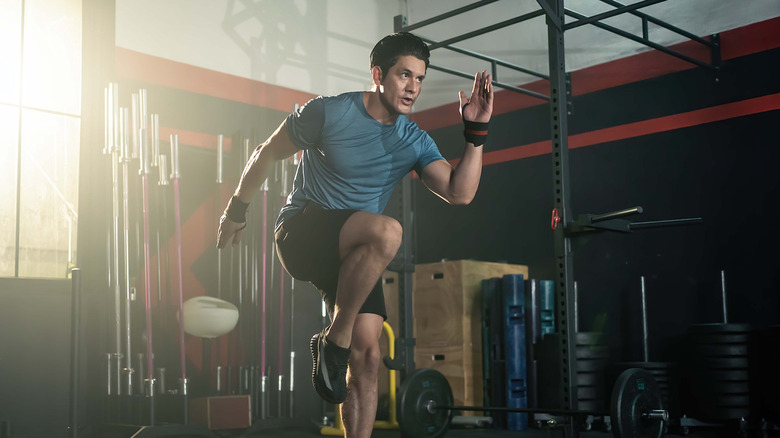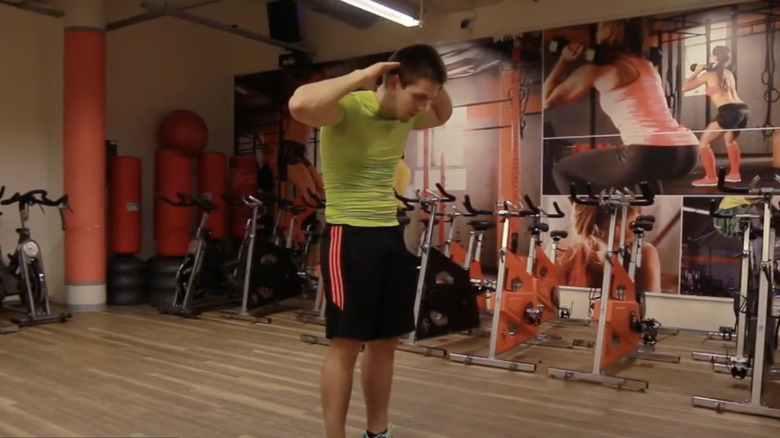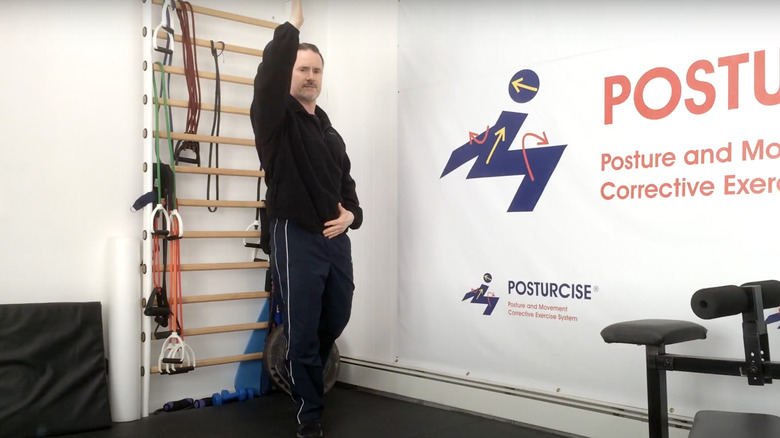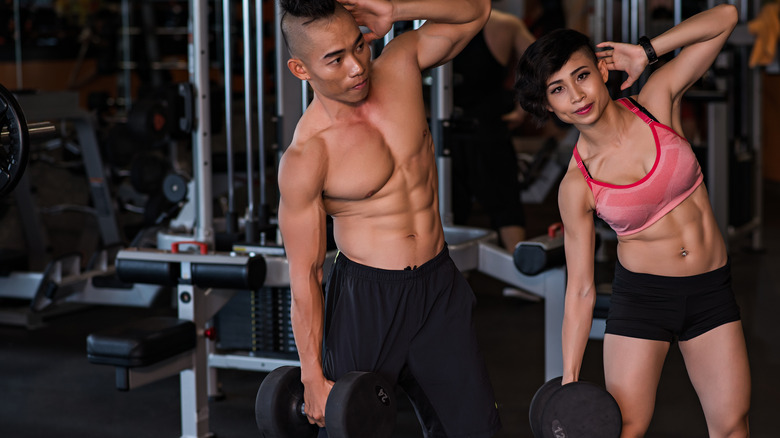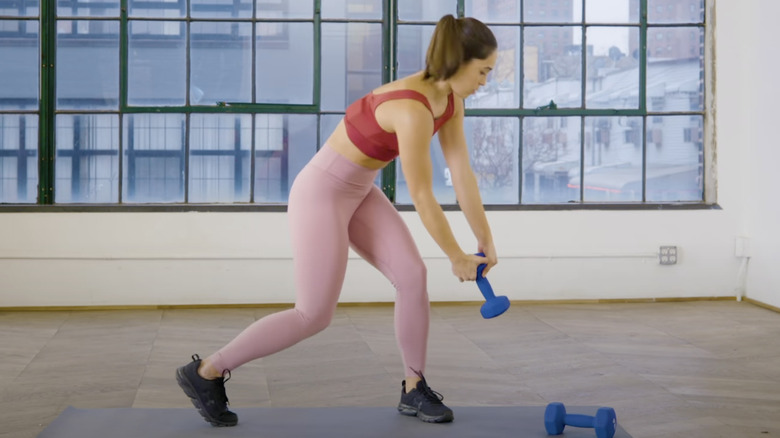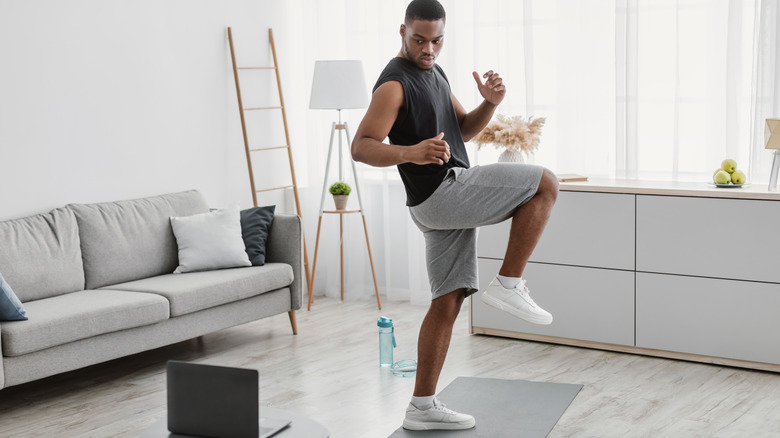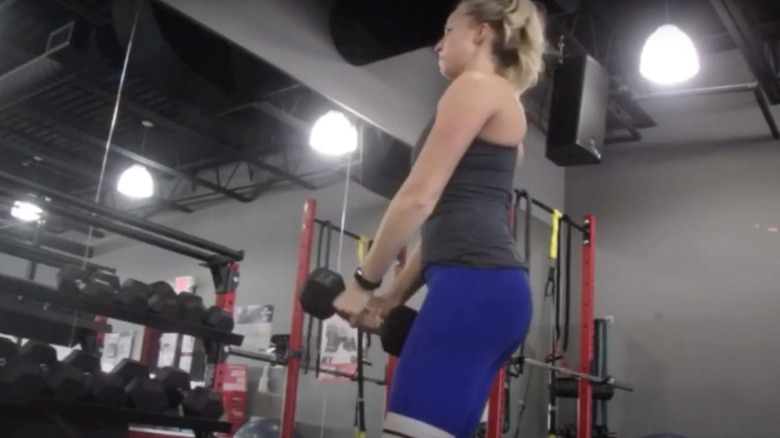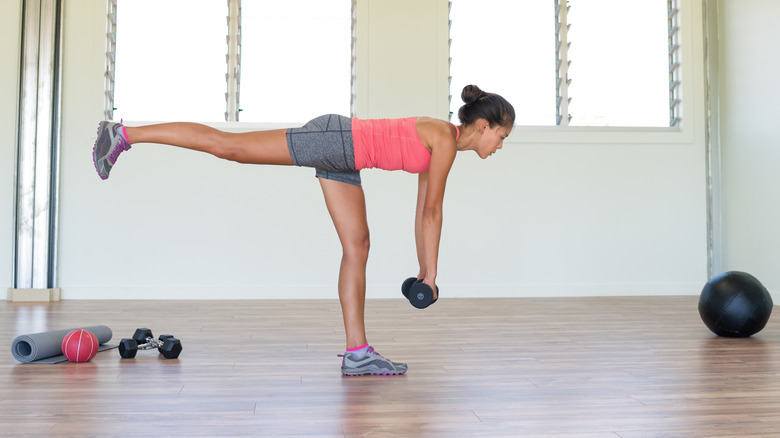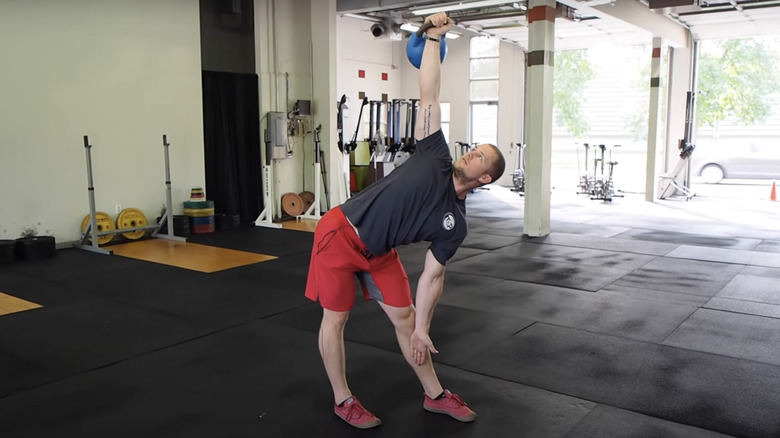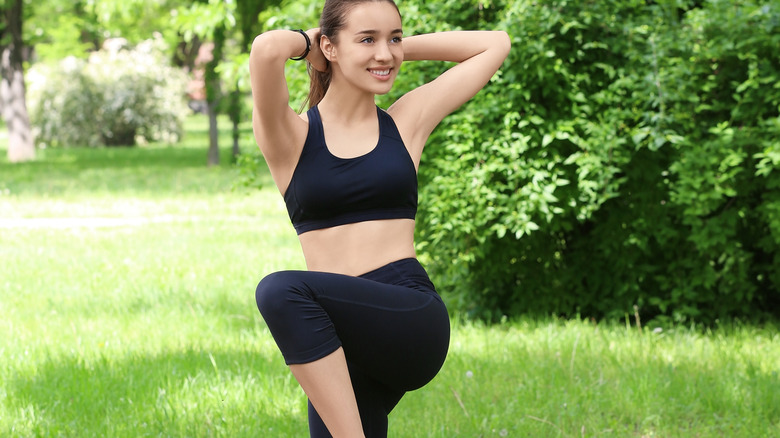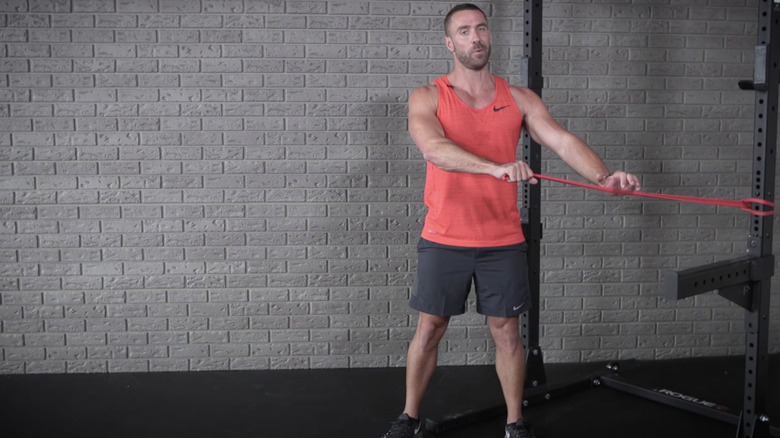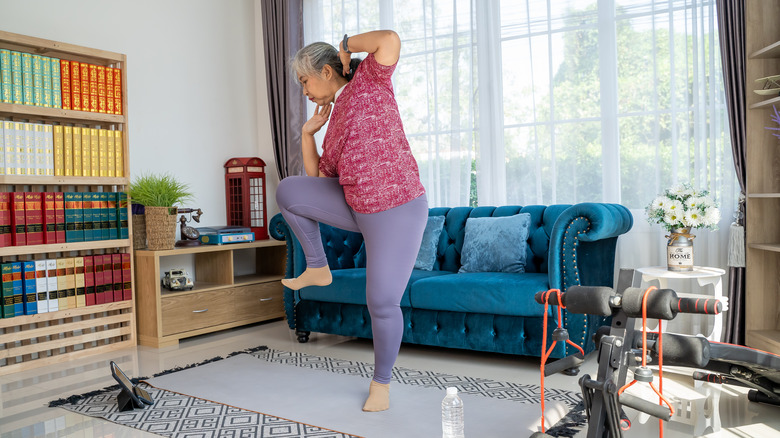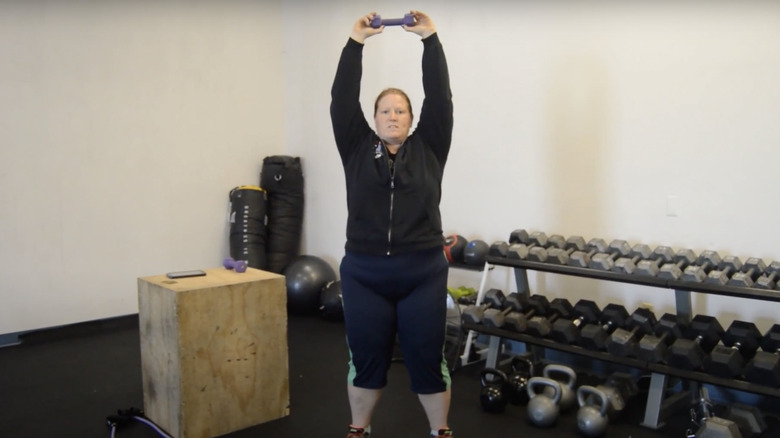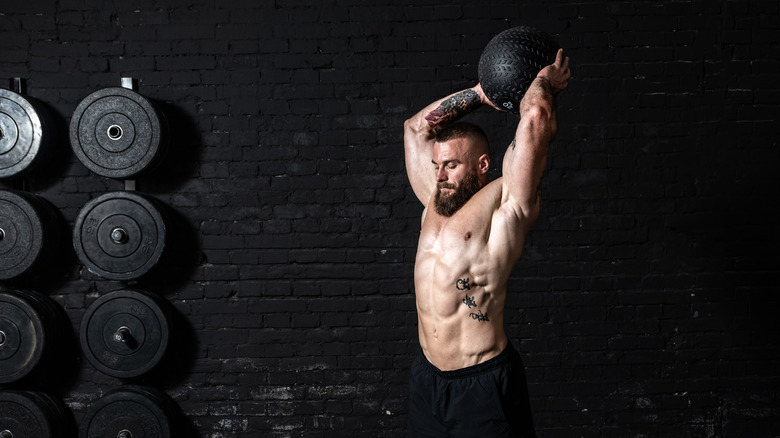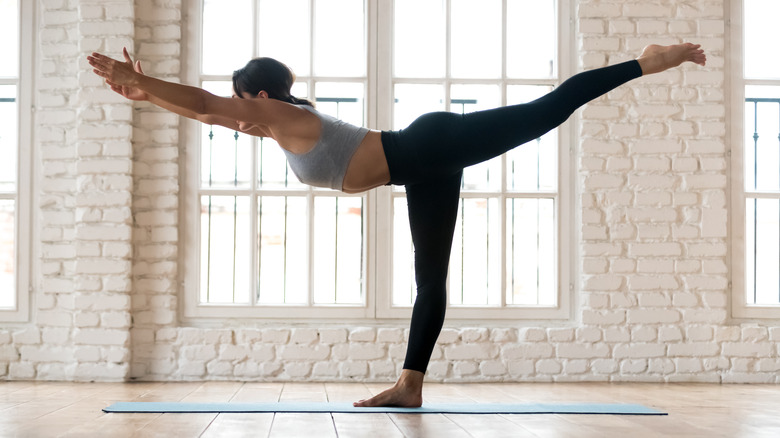The Best Standing Ab Exercises To Strengthen Your Core
Having a strong core is essential to overall health and fitness. In addition to providing a set of rock-hard abs, solid core muscles are also vital to your overall stability and posture, and given that they're involved in almost every major exercise, help to make your overall workout performance better (per the Mayo Clinic). And anyone familiar with core exercises will know that you're normally spending a lot of time on the floor, on your back, doing endless crunches and sit-ups, and counting down the seconds until they're over.
But let's mix it up a bit. What if we told you that you can work out your core ... while standing? We know, your minds are blown. But in fact, standing core exercises are not only a refreshing change from floor work, but also provide their own benefits.
"With standing ab work, you can achieve a greater range of motion working the abdominal muscles through their entire length," says Board30 founder Floery Mahoney. Standing ab exercises are also not only based around more functional movements that you do in daily life, but they put less strain on your neck muscles, and stop you from having to get up and down endlessly in your workout, according to Mahoney. So far, so good — but which ones are right for you? Let's go explore!
Standing crunch
One of the simplest standing ab moves to learn involves taking your regular crunch, and turning it vertical. And like a crunch performed on the floor, this exercise will seriously fire up your abs, without any need for a mat or additional equipment (per Masterclass). One of the added benefits of a standing crunch, too, is the activation you get through your lower body, with the slight squatting motion also providing a workout to your legs and glutes.
To perform a standing crunch, begin in an upright position, with your feet planted slightly wider than your hips and toes pointing in front of you, says CosmoBody trainer Katia Pryce via Cosmopolitan. Then, position your hips forward slightly, activating your abs and drawing your belly button in as you do so. Once your abs are engaged, send your hips back, bending your knees slightly — as you move your chest forward — in a crunching motion, ensuring that you don't bunch up your neck as you do so.
Return to your original position, and repeat between 10-15 times for a complete set, aiming for three sets in total.
Standing bird dog
The regular bird dog exercise, performed on your knees on a mat, is one of the best moves you can do to target your entire core (per SELF). But they can be problematic for people who have trouble kneeling or bearing weight on their knees or wrists, so doing it in a standing position could be the perfect adjustment. Not only does it hit your core hard, but it'll also test your stability and balance, especially if you're doing it in a slow, controlled motion (per Healthline).
Begin standing facing forward, with your feet at shoulder-width. Your arms should be hanging loosely by each side. Lift one of your arms, and the opposing leg at the same time, bedding your knee in front of you and inhaling as you do so. Make sure that your other limbs don't move. Keep lifting until the raised arm is pointing toward the ceiling, fully extended above your head, and your leg is bent at a 90-degree angle to your body. Hold the position there briefly, and then return your limbs to the starting position, on an exhale, before repeating with the other arm and leg.
Dumbbell side bend
Although many core exercises are performed with bodyweight alone, adding weights into the mix can provide your abs with additional resistance to supercharge your workout. And with just a pair of dumbbells, you can target your core (and obliques specifically) on your feet with the dumbbell side bend, an accessible move that even beginners can do (per Muscle and Strength).
You start the move, as you might imagine, by standing on your feet. Face your entire body forward with your feet a regular distance apart, and hold a dumbbell in each hand, hanging loosely by your sides with your palms facing toward your body. Then, slowly start to lower one of the dumbbells down, bending your body sideways to do so, without your feet moving or your back bending. Once you've bent as far as you can go, pull the dumbbell back up so that you're in a standing position, and then immediately lean to the other side with the same motion. Make sure that your obliques are engaged during the movement, and don't let the dumbbells swing out too much. Repeat for as many reps as you can, and then rest.
Wood chop
We love an exercise move that has a catchy name. But the wood chop has more going for it than just invoking images of standing in your garden felling trees: It's also an excellent standing core move. The wood chop (named, as you can probably guess, because it mimics the movement of chopping wood) is also a fantastic way to fire up other parts of your body, with the exercise not only working out your abs and obliques, but also activating your lower back, lower body, and shoulders, explains Spotebi.
Grab a dumbbell, and stand up straight, holding the weight in front of you. Lift the dumbbell up and to the side while simultaneously rotating your body, until you're holding it above and away from you, extended out from your body. Next, bring the dumbbell back down and across your body — without bending your arms — squatting and rotating your core until you're holding it next to your other knee, in a wood-chopping movement. Keep your core engaged while you do the move, and don't twist your feet — they should remain pointing forward.
Lunge crunch
One of the best things about standing ab exercises is that they frequently incorporate other parts of your body so that you get more bang for your (exercise) buck. Such is the case with a lunge crunch, which emulates the movement of a one-leg crunch for your abs but also works out your legs and lower body.
To start, move into a lunge, explains Pure Wow. Take a step forward with one leg and move your body weight forward until your front thigh is parallel to the floor, with your other leg remaining straight behind you. Raise your arms in front of you, palms facing inward, and then on an exhale, pull your back knee up, shifting the weight onto your front leg as your knee drives forward and toward your abs. Contract your abs as you do this, and bring your arms down, so that your knee passes through them. You must do this move as quickly as you can without losing balance, as the explosive nature of it is what will help work your abs. Return your foot to its starting position, and then repeat immediately, doing a total of 15 reps before switching legs.
Dumbbell pull-over
Core exercises frequently involve a crunching or contracting motion, bringing the upper and lower body together to work the abs. But an equally-brilliant result can be obtained from working with overhead resistance, notes Runner's World. Standing ab exercises are uniquely placed to work with overhead weight to target your core, and this can assist in working your obliques and deep core muscles, essential for providing balance and stability during other activities like running, advises strength and running coach Jess Movold.
Few exercises involve overhead resistance as well as the dumbbell pull-over. Grab a dumbbell, and hold it in front of you, with your arms extended (but not locked) and your back straight. Then, keeping your arms straight, lift the dumbbell up and over your head, activating your core as you do so. Once your arms are extended over your head, pause briefly, and then bring the weight back down, moving slowly and keeping your core engaged. If you feel tension or activation through your shoulders, the weight is likely too heavy, so switch it out for a lighter one. Complete around 12 reps of the exercise before resting.
Single-leg straight-leg deadlift
Trust us — you'll want this exercise in your repertoire. The single-leg straight-leg deadlift (say that 10 times!) is an awesome move that targets a frankly wild amount of muscles, including, importantly, your core. "You'll use your hamstrings and glutes to hinge forward, your hips and core to balance, and your upper back and shoulders to keep your torso from getting pulled into a rounding position by the weight of the dumbbells," says BJ Gaddour, certified strength and conditioning specialist (via Men's Health). In addition, the single-leg straight-leg deadlift works on your hip mobility and helps to build stability in your knee.
Stand with a dumbbell in each hand, held by your sides, with your back straight and shoulders back. Shift your weight onto one leg, activating the glutes, and bend the knee while your other leg remains straight, moving up and back off the floor. As the weights lower toward the ground, your leg should continue to rise behind you, until your back leg and torso are in a straight line, parallel to the floor. Driving through your bent leg, lift the weights back up and move your leg back down, until it touches the floor and your body's upright. Repeat for as many reps as you can do, and then rest.
Kettlebell windmill
While some standing ab exercises are pretty simple, others can be harder to perfect. But nothing worth having ever comes free, right? That's why we think it's worth your time to master the kettlebell windmill. While potentially tricky at first, the kettlebell windmill will fire up your abs and obliques while also challenging your balance — and the wide-ranging movement of the exercise helps to develop better mobility.
Begin by standing with your feet slightly wider than usual, and turn one of them out to the side, keeping the other pointing straight forward. Take a kettlebell, and hold it above your head, holding it on the side of the pointing-forward foot. Then, bend your body toward the pointed-out foot, allowing your glutes and hips to push back in the direction of the other leg as you do so. As you bend, bring your free hand down to meet your foot, keeping your body straight, and holding the kettlebell above you at all times. You should watch the weight as you do this movement to maintain form (and make sure, naturally, that you're not going to drop it). Then, return your body to its original position, maintaining form as you do so, before repeating.
Standing bicycle crunch
The bicycle crunch is a staple of ab workouts worldwide, and for good reason. It's one of the most efficient core exercises around, and was actually found to be the most effective of a range of 13 different workout moves for targeting the abs and obliques, according to a study sponsored by the American Council on Exercise (per ACE Fitness). The bicycle crunch can be challenging for some individuals, though, which is why we love the standing version, which gives you the benefits of the regular bicycle crunch without extended time on your back and rocking against your spine.
Stand up straight, with feet shoulder-width apart. Then, raise one of your knees while bringing the elbow of the opposing arm down to meet it, crunching your core as you do so. Your knee and elbow should, if possible, connect lightly at around midriff level — try and touch the inside of the elbow and knee to each other gently, to avoid any painful knocks. Return your body to its original position, and then repeat on the other side. Try and aim for 10 reps on each side, for a total of three sets.
Band core rotation
It feels like there are thousands of workout moves that promise to give you a rock-hard six-pack — but what about your obliques? Those moves can be slightly harder to find, and those muscles harder to focus on. That's where the band core rotation comes in. Using a twisting motion, this move works deep into your obliques, while also activating the other muscles throughout your core, according to Cam Byrnes, personal trainer and training advisor to Men's Health Australia (via Men's Health).
To do this move, you'll need a resistance band and exercise rack, or something equally as sturdy. Tie the resistance band to the rack at about navel height, and stand next to it, holding it across your body with the hand furthest away. Pull the resistance band toward you, and as you do so, rotate your core, so that your body is turning away from the rack. You can use your other hand to stabilize your body, by placing it lightly on the band. Once your body has rotated as far as is comfortable, return to the starting position, and immediately rotate again, for 10 reps. Then, switch sides and repeat without resting, before flipping back to the other side, alternating for four sets in total.
Standing side crunch
Even when you're standing on your feet, you can't escape the crunch, folks. And we can understand why: As far as movements go, it's pretty exemplary at working your abs. Side crunches are especially good for working your oblique muscles, but can be challenging if you're not comfortable with floor work. Luckily, though, the standing side crunch can have the same effect and can work your hips too (per Spotebi).
Begin by standing up straight, with your spine elongated and your feet a comfortable width apart. Place your hands behind your head. Then, move your weight onto one leg, maintaining a slight bend in the knee. Lift the other leg off the floor and up to your side, in a crunching movement, while also bringing the elbow on the same side down. Contract your obliques as you do so, especially when your core is at its crunch-iest — and then lower your leg back onto the floor, moving your elbow back to its starting position. Ensure that the movement here is sideways-focused, as you don't want your spine to bend or your chest to cave inward. Repeat on the other side, for one full rep.
Overhead circles
Now and again, an exercise move comes along that just looks fun to do. And that's why we love overhead circles, which use a somewhat unconventional movement for ab exercises to help sculpt your core. Don't be fooled by how simple it looks, though: The movement for overhead circles may not be vast, but the effect certainly will be (per Healthline).
Grab a dumbbell, and stand upright on your mat, with length through your spine and your neck long and relaxed. Then, lift your dumbbell above your head, holding it with a hand on either end. Activate your core, and start to move the dumbbell above you in horizontal circles, as though you're drawing a hoop above your head. As you do this, your torso should move too, rotating slightly in line with the rotation of the dumbbell. Repeat the movement in the same direction for as many reps as you like (try aiming for 10-15 to begin, and see how you feel), and then repeat the movement in the opposite direction, before resting.
Medicine ball slam
Ab exercises are often focused on smaller, repeated movements to engage the core and get those microtears in your muscle fiber that lead to strength and sculpting. But sometimes big, explosive movements is what you're after. The medicine ball slam provides just that and is not only incredible for targeting your core and upper back but works muscles throughout the rest of your body too (per Coach Magazine). As a bonus, it's a great way to release your frustrations.
Begin by holding a medicine ball over your head, ensuring that it's not too heavy. Then, it's pretty simple, folks: Slam that ball forward and into the ground in front of you. Remember that this is a full-body movement, so your full body should be activating here.
"When you throw the ball, your hips hinge backwards to bring in your glutes and hamstrings. Your aim should be to come down as violently as possible," says Jack Lovett, Spartan Performance gym owner. As your body comes down, keep your abs engaged, and catch the ball as it bounces back up (or pick it up off the floor, if you have one that doesn't have any bounce in it). Repeat the movement around 15 times if you can, for a full set, aiming for three sets in total.
Warrior balance
Now, we don't know about you, but when we do our workouts, we like to feel strong. And few movements will help you do that like the warrior balance — not just because it's got a pretty cool-sounding name. The warrior balance uses a slow, controlled movement to tone your core, while also providing a serious challenge to your balance and stability and activation through the lower body.
Stand up straight, and then shift your weight onto one leg, as SELF explains. Raise the knee of your other leg in front of you, until it's at a 90-degree angle, and hold your hands out in front of you too, bent at the elbow. Then at the same time, extend your upper body and arms forward while extending your bent leg backward, maintaining balance through the supporting leg as you do so. Keep going until you've got a long, straight line, from the tips of your fingers to the heel of your foot. Hold the position there, and then return your leg and body to the original position, with your knee in front of you — repeat the balance pose 10 times before switching to the other foot.

